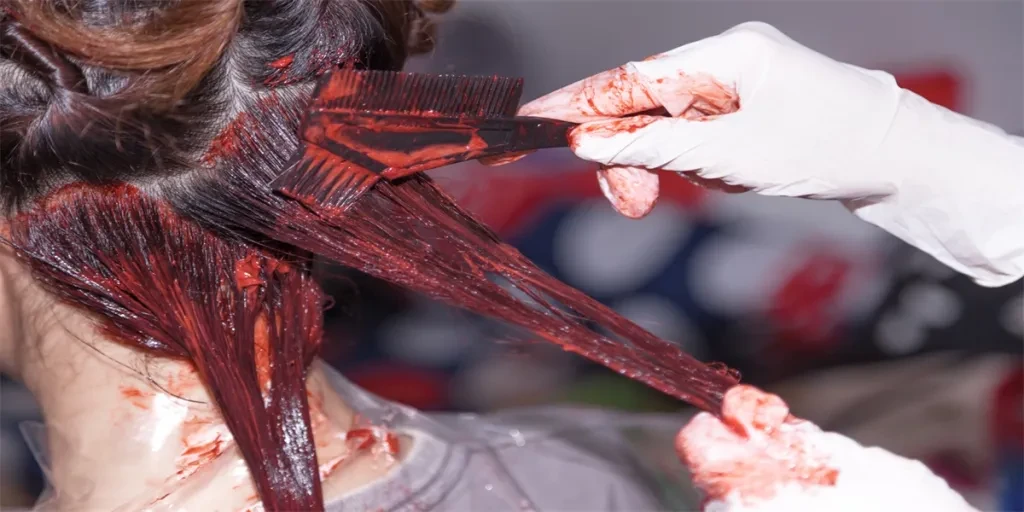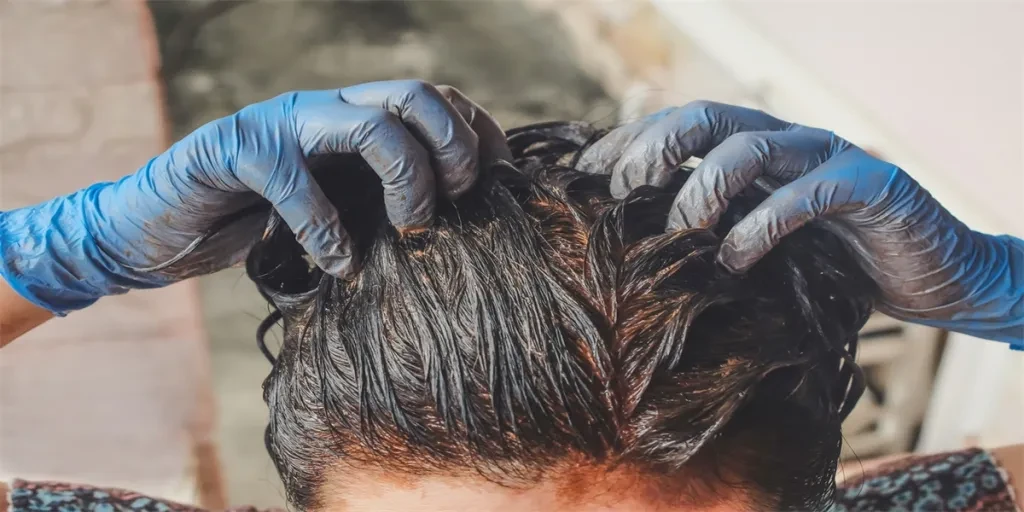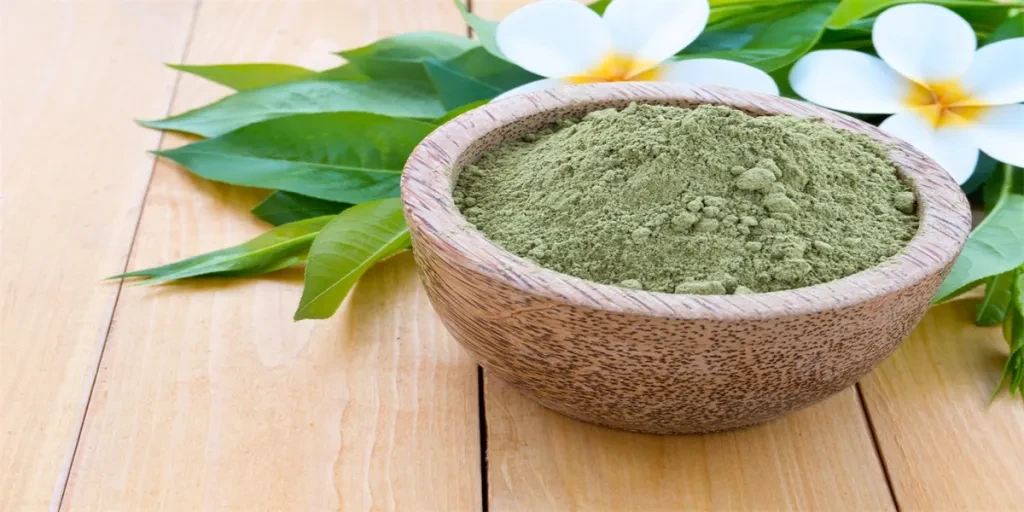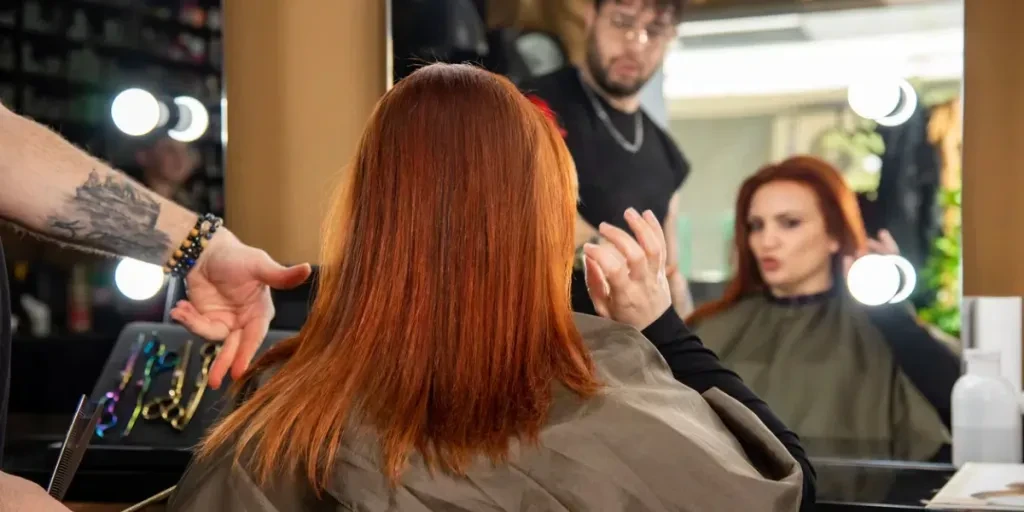La coloration capillaire au henné fait des vagues dans l'industrie de la beauté, captivant l'attention des consommateurs et des acheteurs professionnels. À l'aube de 2025, la demande de produits de beauté naturels et durables est à son apogée, et la coloration capillaire au henné est à l'avant-garde de cette tendance. Ce guide se penche sur l'essence de la coloration capillaire au henné, sa popularité croissante et le potentiel commercial qu'elle recèle pour l'avenir.
Sommaire :
– Comprendre la coloration capillaire au henné et son potentiel commercial
– Découverte des types populaires de produits de coloration capillaire au henné
– Répondre aux problèmes des consommateurs et proposer des solutions
– Innovations et nouveaux produits sur le marché de la coloration capillaire au henné
– Réflexions finales sur la sélection des meilleurs produits de coloration capillaire au henné
Comprendre la coloration capillaire au henné et son potentiel commercial

Qu'est-ce que la coloration capillaire au henné et pourquoi gagne-t-elle en popularité ?
La coloration capillaire au henné, dérivée de la plante Lawsonia inermis, est un colorant naturel utilisé depuis des siècles pour colorer les cheveux, la peau et les ongles. Contrairement aux colorants synthétiques, le henné est réputé pour sa capacité à fournir une couleur riche et vibrante tout en revitalisant les cheveux. La prise de conscience croissante des effets nocifs des teintures capillaires chargées de produits chimiques a conduit à une augmentation de la popularité du henné. Les consommateurs recherchent de plus en plus des produits qui sont non seulement efficaces, mais aussi sûrs et respectueux de l'environnement. Le henné correspond parfaitement à ce profil, offrant une alternative naturelle qui s'inscrit dans le mouvement de la beauté propre.
Hashtags tendance sur les réseaux sociaux et sujets de tendance plus larges
À l’ère du numérique, les réseaux sociaux jouent un rôle essentiel dans la définition des préférences et des tendances des consommateurs. Des hashtags tels que #HennaHair, #NaturalHairColor et #EcoFriendlyBeauty gagnent du terrain, reflétant l’intérêt croissant pour les solutions de coloration capillaire naturelles. Les influenceurs et les passionnés de beauté présentent leurs transformations capillaires au henné, renforçant encore davantage la tendance. De plus, des thèmes plus larges comme #SustainableBeauty et #CleanBeauty trouvent un écho auprès des consommateurs qui sont de plus en plus conscients de leurs choix de beauté. Ces tendances ne sont pas seulement passagères ; elles sont le signe d’une évolution plus large vers des pratiques de beauté holistiques et durables.
Domaines de croissance de la demande et potentiel du marché
Le potentiel commercial de la coloration capillaire au henné est immense, notamment dans les régions où les produits naturels et biologiques sont très prisés. Selon un rapport de Research and Markets, le marché mondial de la coloration capillaire devrait connaître une croissance significative, avec une augmentation notable de la demande de colorants capillaires naturels comme le henné. La région Asie-Pacifique, connue pour son riche patrimoine culturel et ses pratiques de beauté traditionnelles, devrait contribuer largement à cette croissance. Des pays comme l'Inde, où le henné est utilisé depuis des générations, connaissent un regain de popularité.
En outre, l’essor du commerce électronique et des plateformes de vente au détail en ligne a facilité l’accès des consommateurs à une large gamme de produits à base de henné. Cela a ouvert de nouvelles perspectives aux acheteurs professionnels, notamment aux détaillants et aux grossistes, pour exploiter ce marché en plein essor. Le nombre croissant de salons et de spas proposant des services de coloration des cheveux au henné stimule également la demande. Alors que les consommateurs continuent de privilégier la santé et la durabilité, le marché de la coloration des cheveux au henné est sur le point de connaître une forte croissance dans les années à venir.
En conclusion, la coloration capillaire au henné n’est pas seulement une tendance ; elle reflète un mouvement plus large vers des solutions de beauté naturelles et durables. Avec sa riche histoire, ses bienfaits prouvés et son potentiel de marché croissant, le henné est en passe de devenir un incontournable de l’industrie de la beauté. Les acheteurs professionnels qui cherchent à capitaliser sur cette tendance devraient envisager d’intégrer la coloration capillaire au henné dans leur offre de produits pour répondre aux demandes évolutives des consommateurs en 2025.
Découverte des types populaires de produits de coloration capillaire au henné

Henné naturel vs henné mixte : avantages et inconvénients
Lors de la sélection de produits de coloration capillaire au henné, les acheteurs professionnels doivent comprendre les différences entre le henné naturel et le henné mélangé. Le henné naturel, dérivé de la plante Lawsonia inermis, est réputé pour sa composition pure et sans produits chimiques. Il offre une teinte brun rougeâtre riche et est apprécié pour ses propriétés revitalisantes, rendant les cheveux plus forts et plus brillants. Cependant, la gamme de couleurs du henné naturel est limitée, ce qui peut ne pas plaire aux consommateurs à la recherche de nuances variées.
En revanche, les produits à base de henné mélangés combinent du henné naturel avec d’autres ingrédients botaniques ou des colorants synthétiques pour élargir la palette de couleurs. Ces produits peuvent offrir une variété de nuances, du noir au blond, s’adressant à une clientèle plus large. Cependant, l’inclusion de colorants synthétiques peut susciter des inquiétudes quant aux réactions allergiques potentielles et aux dommages capillaires. Les acheteurs professionnels doivent s’assurer que les produits à base de henné mélangés répondent aux normes de sécurité et sont exempts de produits chimiques nocifs comme le PPD (paraphénylènediamine), qui peut provoquer de graves réactions allergiques.
Ingrédients clés et leurs avantages
Les produits de coloration capillaire au henné contiennent souvent un mélange d'ingrédients naturels qui améliorent leur efficacité et leur attrait. Des ingrédients comme l'amla (groseille indienne) et le shikakai (Acacia concinna) sont généralement ajoutés aux formules de henné. L'amla est riche en vitamine C et en antioxydants, favorisant la croissance des cheveux et prévenant le grisonnement prématuré. Le shikakai agit comme un nettoyant et un revitalisant naturel, améliorant la texture et la brillance des cheveux.
Parmi les autres ingrédients bénéfiques, on trouve le bhringraj (Eclipta alba) et le neem (Azadirachta indica). Le bhringraj est connu pour sa capacité à renforcer les follicules pileux et à réduire la chute des cheveux, tandis que le neem possède des propriétés antifongiques et antibactériennes qui aident à maintenir un cuir chevelu sain. Les acheteurs professionnels doivent rechercher des produits au henné qui intègrent ces ingrédients pour offrir une valeur ajoutée aux consommateurs à la recherche de solutions de soins capillaires holistiques.
Commentaires des consommateurs et efficacité
Les avis des consommateurs sont essentiels pour les acheteurs professionnels lors du choix de produits de coloration capillaire au henné. Selon un rapport de Research and Markets, les consommateurs apprécient le henné pour son origine naturelle et ses bienfaits revitalisants. De nombreux utilisateurs signalent une amélioration de la texture des cheveux et une réduction de la chute des cheveux après une utilisation régulière de produits à base de henné. Cependant, certains consommateurs expriment des inquiétudes quant au processus d'application fastidieux et à l'odeur forte et terreuse du henné naturel.
Les produits à base de henné mélangés reçoivent des avis mitigés, certains consommateurs louant la variété des nuances et la facilité d'application, tandis que d'autres signalent des problèmes d'uniformité des couleurs et une irritation potentielle du cuir chevelu. Les acheteurs professionnels doivent tenir compte de ces facteurs et sélectionner des produits qui équilibrent les préférences des consommateurs pour les ingrédients naturels avec la demande d'options de couleurs diverses et de méthodes d'application conviviales.
Résoudre les problèmes des consommateurs et proposer des solutions

Problèmes courants liés à la coloration des cheveux au henné
Les produits de coloration capillaire au henné, bien que populaires, présentent certains défis que les acheteurs professionnels doivent relever. L'un des problèmes courants est la longueur du processus d'application, qui peut dissuader les consommateurs de rechercher des solutions de coloration capillaire rapides et pratiques. Le henné naturel nécessite plusieurs heures pour développer sa couleur, ce qui peut ne pas être pratique pour tous les utilisateurs.
Un autre problème est la gamme de couleurs limitée du henné naturel, qui offre principalement des nuances de rouge et de brun. Les consommateurs à la recherche de couleurs plus vives ou variées peuvent trouver le henné naturel insuffisant. De plus, la forte odeur du henné peut être rebutante pour certains utilisateurs, et le risque de tacher la peau et les vêtements lors de l'application est un inconvénient notable.
Solutions pour améliorer l'expérience utilisateur
Pour améliorer l'expérience utilisateur, les acheteurs professionnels peuvent envisager de proposer des produits à base de henné pré-mélangés qui réduisent le temps de préparation. Ces produits peuvent être formulés avec des ingrédients naturels supplémentaires pour améliorer le développement de la couleur et réduire le temps d'application. Par exemple, l'ajout de jus de citron ou de thé peut aider à libérer la teinture plus rapidement, ce qui rend le processus plus efficace.
L'ajout de parfums aux produits à base de henné peut résoudre le problème des odeurs fortes. Des huiles essentielles comme la lavande ou le romarin peuvent être incorporées pour offrir un parfum agréable, rendant le processus d'application plus agréable. De plus, fournir des instructions claires et des outils d'application, tels que des gants et des pinceaux applicateurs, peut aider à minimiser le risque de taches et à améliorer la satisfaction globale de l'utilisateur.
Conseils pour une application et des résultats optimaux
Pour une application et des résultats optimaux, les acheteurs professionnels doivent informer les consommateurs des meilleures pratiques d'utilisation des produits de coloration capillaire au henné. Conseiller aux utilisateurs d'effectuer un test cutané avant l'application complète peut aider à identifier les réactions allergiques potentielles. Encourager l'utilisation d'un shampooing clarifiant avant l'application du henné peut garantir que les cheveux sont exempts d'accumulation de produit, permettant une meilleure absorption de la teinture.
Il est recommandé d'utiliser un bonnet en plastique et de chauffer pendant le processus d'application pour favoriser le développement de la couleur. La chaleur aide à ouvrir les cuticules des cheveux, permettant au henné de pénétrer plus profondément et de produire une couleur plus vive. Des conseils d'entretien ultérieur, comme éviter le shampooing pendant 48 heures après l'application et utiliser des shampooings sans sulfate, peuvent aider à maintenir la couleur et à prolonger sa longévité.
Innovations et nouveaux produits sur le marché de la coloration capillaire au henné

Dernières innovations en matière de formulations de coloration capillaire au henné
Le marché des colorations capillaires au henné connaît des innovations importantes visant à améliorer les performances des produits et l'expérience utilisateur. Une tendance notable est le développement de teintures capillaires à base de henné qui intègrent des extraits botaniques avancés et des rehausseurs de couleur naturels. Ces formulations visent à offrir un spectre de couleurs plus large tout en préservant les bienfaits naturels du henné.
Par exemple, certaines marques expérimentent l’inclusion d’indigo et de cassia pour créer une gamme plus large de nuances, des noirs profonds aux blonds dorés. Ces innovations s’adressent aux consommateurs à la recherche d’options de coloration capillaire naturelles sans compromettre la diversité des couleurs. De plus, l’utilisation de la technologie de microencapsulation est à l’étude pour améliorer la stabilité et la libération des colorants au henné, garantissant ainsi des résultats de couleur uniformes et durables.
Produits émergents et leurs caractéristiques uniques
Les nouveaux produits sur le marché de la coloration capillaire au henné sont conçus pour répondre aux besoins et préférences spécifiques des consommateurs. Par exemple, le kit de coloration capillaire semi-permanente Color Remix de göt2b offre des niveaux d'éclat personnalisables, permettant aux utilisateurs d'atteindre l'intensité souhaitée. Ce produit présente également un processus d'application simple, destiné aux consommateurs qui privilégient la commodité et la facilité d'utilisation.
Les colorations Clairol Bold & Bright sont un autre produit innovant qui intègre la technologie TrueColorSeal pour protéger les cheveux contre la décoloration due à l'eau. Cela permet de préserver l'éclat de la couleur plus longtemps, ce qui répond à une préoccupation courante chez les consommateurs qui se lavent fréquemment les cheveux. Ces produits soulignent l'importance accordée par l'industrie à la combinaison d'ingrédients naturels et de technologies avancées pour répondre aux demandes changeantes des consommateurs.
Tendances futures à surveiller en matière de coloration capillaire au henné
À l’avenir, le marché de la coloration capillaire au henné devrait continuer d’évoluer en mettant l’accent sur la durabilité et la personnalisation. À mesure que les consommateurs deviennent plus soucieux de l’environnement, la demande pour des emballages écologiques et des ingrédients d’origine éthique va augmenter. Les marques qui accordent la priorité à la durabilité dans le développement et l’emballage de leurs produits auront probablement un avantage concurrentiel.
La personnalisation est une autre tendance clé, les consommateurs recherchant des solutions de coloration adaptées à leurs préférences et à leur type de cheveux. L’utilisation d’outils basés sur l’IA pour les essais virtuels et la correspondance des teintes personnalisées devrait devenir plus courante, permettant aux consommateurs d’expérimenter différentes couleurs avant de procéder à un achat. Cette tendance s’inscrit dans le mouvement plus large vers la beauté personnalisée et l’expression de soi.
Réflexions finales sur la sélection des meilleurs produits de coloration capillaire au henné

En conclusion, la sélection des meilleurs produits de coloration capillaire au henné nécessite une compréhension complète des préférences des consommateurs et des tendances du marché. Les acheteurs professionnels doivent privilégier les produits qui offrent un équilibre d'ingrédients naturels, diverses options de couleurs et des méthodes d'application conviviales. En restant à l'écoute des innovations et en abordant les problèmes courants des consommateurs, les entreprises peuvent répondre efficacement à la demande croissante de produits de coloration capillaire au henné et renforcer leur présence sur le marché.





 Afrikaans
Afrikaans አማርኛ
አማርኛ العربية
العربية বাংলা
বাংলা Nederlands
Nederlands English
English Français
Français Deutsch
Deutsch हिन्दी
हिन्दी Bahasa Indonesia
Bahasa Indonesia Italiano
Italiano 日本語
日本語 한국어
한국어 Bahasa Melayu
Bahasa Melayu മലയാളം
മലയാളം پښتو
پښتو فارسی
فارسی Polski
Polski Português
Português Русский
Русский Español
Español Kiswahili
Kiswahili ไทย
ไทย Türkçe
Türkçe اردو
اردو Tiếng Việt
Tiếng Việt isiXhosa
isiXhosa Zulu
Zulu